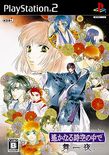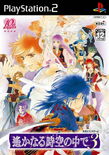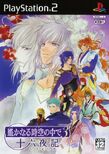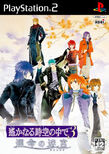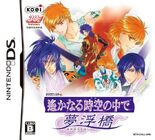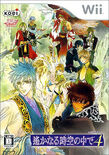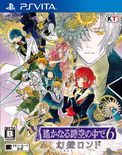- The Japanese romanization is being used for this wiki because the games themselves have remained unlocalized in English.
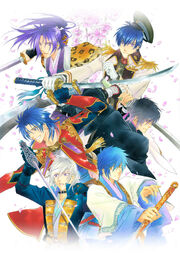
Fifteenth anniversary Mizuno illustration featuring the Seiryu of Heaven Guardians in the series
The Harukanaru Toki no Naka de (遙かなる時空の中で; Literally: "Within a Distant Time") series is a romantic adventure video game series made by Ruby Party for the female audience. Variations of the Japanese romanization found in official sources include "Harukanaru Tokinonakade", "Haruka naru tokino nakade", "Harukanaru Tokino Nakade" or "Harukanaru Toki no Nakade". The animated TV series and the comic adaptation of the first entry and Warriors All-Stars lists the official English localized title of this series as Haruka: Beyond the Stream of Time.
Officially abbreviated as Haruka (遙か), it is the second entry in the Neoromance series. Characters are designed and illustrated by Tohko Mizuno.
Made to deliberately contrast the setting found in Angelique, the Harukanaru Toki no Naka de series is an Eastern themed fantasy story. Each entry borrows elements from various periods of Japanese history or mythology; to be true to actual history, several titles are additionally reliant on ancient Indian or Chinese theologies and stories. The first Harukanaru Toki no Naka de followed the burst of popularity for Heian period based media, becoming an instant hit with female consumers. The first two games featured characters who were roughly based on historical facts or stories. Characters began to be based on actual historical or mythological figures since Harukanaru Toki no Naka de 3.
Ruby Party developers made the series specifically to satisfy fan surveys, which requested a role-playing game title with a new cast of characters. Each installment offers a different setting, story, and tone, with random battles and a loose leveling system. The game's adventure-like flow separates it from other Neoromance entries. The development team aimed to create individual narratives for each character, adding a feeling of loss and tragedy. The protagonists are vocal and proactive in solving individual problems.
Setting[]
In each game, a parallel world, primarily Japan, is inhabited by two dragon gods, the White Dragon and the Black Dragon. These gods maintain balance by gently watching over the inhabitants, ensuring a peaceful balance. However, if human affairs disturb this balance, dangerous irregularities may occur, corrupting deities and spirits, and causing pestilence, famine, and despair. The dragon gods are unwilling to dwell too deeply into human affairs.
The dragon gods endow powers to young girls, who they choose based on their trustworthiness. If they can't find a girl, they can travel through time to find her. The girl is then given the title of priestess and is seen as an honorable living treasure in the parallel world. The protagonists, except for the sixth, are the White Dragon Priestess, with her four servants acting as her aides. Once they form a bond, they can unleash their true powers to defeat their adversaries.
Timeline[]
Like the series's name suggests, each installment is set in a different time era.
- Ancient Japan (mythological setting; year unspecified)
- Harukanaru Toki no Naka de 4
- Heian Period (794~1192) - Kamakura Period (1185~1333)
- Harukanaru Toki no Naka de (10th century)
- Harukanaru Toki no Naka de 2 (11th century)
- Harukanaru Toki no Naka de 3 (12th century)
- Bakumatsu (1853~1869)
- Harukanaru Toki no Naka de 5
- Taishō Period (1912-1926)
- Harukanaru Toki no Naka de 6
- Heavenly Realm (fictional setting; dream world)
- Harukanaru Toki no Naka de Yume no Ukihashi
Games[]
- Harukanaru Toki no Naka de
- Harukanaru Toki no Naka de 2
- Harukanaru Toki no Naka de Banjoyuugi
- Harukanaru Toki no Naka de 3
- Harukanaru Toki no Naka de Hachiyoushou
- Harukanaru Toki no Naka de Iroetebako
- Harukanaru Toki no Naka de 3 Izayoiki
- Harukanaru Toki no Naka de 3 Unmei no Labyrinth
- Harukanaru Toki no Naka de Maihitoyo
- Pocket Scenario Series: Harukanaru Toki no Naka de Maihitoyo
- Harukanaru Toki no Naka de 4
- Harukanaru Toki no Naka de Yume no Ukihashi
- Harukanaru Toki no Naka de Yume no Ukihashi Special
- Harukanaru Toki no Naka de 3 with Izayoiki Aizouban
- Harukanaru Toki no Naka de 3 Unmei no Labyrinth Aizouban
- Harukanaru Toki no Naka de 4 Aizouban
- Harukanaru Toki no Naka de 5
- Harukanaru Toki no Naka de 5 Kazahanaki
- Harukanaru Toki no Naka de 6
- Harukanaru Toki no Naka de 6 Gentou Rondo
- Harukanaru Toki no Naka de 3 Ultimate
- Harukanaru Toki no Naka de Ultimate
- Harukanaru Toki no Naka de 6 DX
- 100man-nin no Harukanaru Toki no Naka de
- Harukanaru Toki no Naka de 7
Related Media[]
Harukanaru Toki no Naka de has several live events, publications, and drama CDs for the franchise. A fan mook series, Haruka Tsushin, was made to cover characters who appear in the first three games.
The comic incarnation of the first game was created by the series's character designer and was published in Lala, concluding in seventeen volumes and into English by Viz Media as a part of their Shojo Beat lineup. Short stories for the other installments are included in select comic volumes in Japan. Illustrated art books of the comic have been published. The fifth installment is being sporadically printed in LaLa DX; two volumes have been compiled for this work. Her illustrations for the games and comics up to 2014 have been compiled into a recent illustration book.
A parody DVD was made for the series. Characters found throughout the games interact with one another in "what-if?" scenarios. The latest series's live event is a collaboration with Hotel Takeshina. Series regulars Kazuhiko Inoue and Souchiro Hoshi act as the hosts to fans who reserve for the dinner talk show.
Karaoke no Tetsujin hosted a collaboration for the five main installments in their private rooms.
Gallery[]
External Links[]
Harukanaru Toki no Naka de
|
|---|
| Harukanaru Toki no Naka de • Banjoyuugi • Hachiyoushou • Iroetebako • Maihitoyo • Pocket Scenario Series • 100man-nin |
| Harukanaru Toki no Naka de 2 |
| Harukanaru Toki no Naka de 3 • Izayoiki • Unmei no Labyrinth |
| Harukanaru Toki no Naka de Yume no Ukihashi |
| Harukanaru Toki no Naka de 4 |
| Harukanaru Toki no Naka de 5 • Kazahanaki |
| Harukanaru Toki no Naka de 6 • Gentou Rondo |
| Harukanaru Toki no Naka de 7 |
| Characters |
| Harukanaru Toki no Naka de |
| Akane Motomiya • Yorihisa Minamoto • Tenma Morimura • Inori • Shimon Nagareyama • Takamichi Fujiwara • Tomomasa Tachibana • Eisen • Yasuaki Abe • Fujihime • Akram • Iqtidar • Shirin • Sefr • Ran |
| Harukanaru Toki no Naka de Maihitoyo |
| Suefumi Oono |
| 100man-nin no Harukanaru Toki no Naka de |
| Kotengu • Youko • Mamedamuki |
| Harukanaru Toki no Naka de 2 |
| Karin Takakura • Yoritada Minamoto • Katsuzane Taira • Isato • Akifumi • Yukitaka Fujiwara • Hisui • Motomi Minamoto • Yasutsugu Abe • Yukari Fujiwara • Misono Fujiwara • Chitose Taira • Kazuhito • Tokitomo Minamoto |
| Harukanaru Toki no Naka de 3 |
| Nozomi Kasuga • Masaomi Arikawa • Yoshitsune Minamoto • Hinoe • Benkei Musashibou • Yuzuru Arikawa • Kagetoki Kajiwara • Atsumori Taira • Ridvan • Saku Kajiwara • Hakuryu • Yoritomo Minamoto • Masako Hojo • Kiyomori Taira • Tomomori Taira • Tsunemasa Taira • Koremori Taira • Tadanori Taira • Nii no Ama • Emperor Antoku |
| Harukanaru Toki no Naka de 3 Izayoiki |
| Shirogane • Hidehira Fujiwara • Yasuhira Fujiwara |
| Harukanaru Toki no Naka de 3 Unmei no Labyrinth |
| Phantom |
| Harukanaru Toki no Naka de Yume no Ukihashi |
| Beidou Xingjun • Nandou Xingjun |
| Harukanaru Toki no Naka de 4 |
| Chihiro Ashihara • Kazahaya • Asvin • Sazaki • Nagi • Futsuhiko • Hiiragi • Tooya • Oshihito Katsuragi • Iwanagahime • Michiomi Ootomo • Ayuki • Yuugiri • Raja • Nasatya • Shani • Ribhu • Mudgala • Karigane • Sainokimi |
| Harukanaru Toki no Naka de 5 |
| Yuki Hasumi • Shun Kiryu • Ryouma Sakamoto • Chinami • Souji Okita • Tatewaki Komatsu • Ouchi Fukuchi • Ernest Satow • Shinsaku Takasugi • Miyako Yakumo • Amami • Four Gods • Sou Kiryu • Isami Kondou • Toshizou Hijikata • Kaishu Katsu • Shintarou Nakaoka • Makoto • Takamori Saigou • Kogorou Katsura |
| Harukanaru Toki no Naka de 5 Kazahanaki |
| Rindou • Tadayoshi Oguri |
| Harukanaru Toki no Naka de 6 |
| Azusa Takatsuka • Hajime Arima • Darius • Kohaku • Shuhei Katagiri • Rudkhane • Masatora Honjo • Kudan Hagio • Murasame Satoya • Chiyo Komano • Seishiro Katagiri |
| Harukanaru Toki no Naka de 6 Gentou Rondo |
| Man • Naoya Toudou |
| Harukanaru Toki no Naka de 7 |
| Nanao Amano • Yukimura Sanada • Satsuki Amano • Musashi Miyamoto • Yamato Sasaki • Nagamasa Kuroda • Kanetsugu Naoe • Okuni • Munenori Yagyū |
| Other Information |
| Sub Characters • Series Terminology • Walkthroughs |


